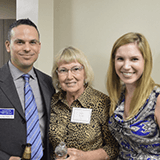Symptoms
Venous symptoms can range from small cosmetic concerns and early warning signs of dangerous underlying issues to debilitating pain and/or ulceration. Some conditions–like varicose veins–deserve more than a cosmetic approach.
-
Aching/Cramping/Itching/Burning
Vein disease symptoms can range from minor cosmetic issues or early signs such as leg pain to major, disabling concerns like ulcers and immobility. If left untreated, things like varicose veins can actually lead to more serious issues because of the progressive nature of the disease. Among these issues are painful blood clots, skin ulcers, and bleeding.
-
Tingling/Numbness
Patients with vein disease will often notice tingling, burning, itching, or numbness in their legs or feet. This itching can ultimately lead to dry skin or a rash called venous eczema. When you feel a burning sensation, it may also come coupled with a throbbing feeling, and your skin might feel slightly numb or warm to the touch. Itching and/or burning on the legs can be a sign of vein disease whether varicose or spider veins are present or not. Due to circulation problems, diabetic patients are 10 times more likely to have vein disease than the general population.
-
Leg Restlessness
Formally referred to as restless leg syndrome (RLS), this condition affects approximately 15% of Americans. In fact, lots of people with an underlying vein disease experience a sensation of restlessness or a constant urge to move their legs. These symptoms are more likely to happen at night and could be the result of inefficient blood flow in the legs because of dysfunctional veins.
-
Skin Changes/Dermatitis
Skin changes in the lower legs may be a sign of vein disease whether or not varicose or spider veins are visible. One common sign of vein disease is darkening of the skin in your lower leg or venous stasis dermatitis. This may cause your skin to appear brown, red, shiny, or irritated. Your skin may even appear to have a rash that is very difficult to heal.
-
Swelling/Lymphedema
Swelling that is caused by an abnormal build-up of fluid in the tissues of your body is called edema. It commonly presents itself as swelling in the lower legs, calves, ankles, and feet. The presence of swelling can be a sign of vein disease. Often, dysfunction of the lymph system causes this swelling. This can go hand in hand with vein disease as poor circulation can contribute to excess fluid.
-
Bleeding in the Legs
Patients with an undiagnosed vein disease can sometimes have episodes of sudden bleeding from surface veins on their legs. Though the bleeding can be significant, it is usually painless. Many people experience this bleeding after an accidental injury, whether from clothing, bedding, pets, brushing against furniture, or bathing. If you notice bleeding from your legs near your veins, be sure to immediately elevate your leg, apply pressure, and seek medical help.
-
Pelvic Pain
Women of childbearing age who experience pelvic pain, pressure, heaviness, or discomfort in their lower abdomen and back often dismiss these sensations as PMS symptoms. In reality, these commonly misdiagnosed symptoms may be caused by damaged pelvic veins.
-
Testicular Pain
Patients experiencing testicular pain, particularly swelling, change in size, discomfort or a mass on your scrotum may be attributed to a venous condition. Valves allow blood to flow from the testicles and scrotum back to the heart, but when they become damaged, they can cause pain in or around the testicles and can contribute to infertility. The result of the backward blood flow is the enlargement of the vein, which may be painful.
-
Chronic Wounds
The most severe stage of vein disease occurs when poor circulation from unhealthy veins causes sustained high blood pressure with a low oxygen supply in lower extremity tissues. This abnormal environment has the potential to create leg wounds known as leg ulcers. Treating the underlying vein disease not only helps to heal venous leg ulcers but treatment also significantly lowers the risk of ulcers coming back when compared to wound care alone.

Since my procedures, I’ve felt so much better in every way. Having my legs treated has been a life-changing event. I have walked more in the past 2 days than I have in the past 2 months.
Philip D.
I had a severe case of restless leg syndrome and my legs hurt and felt heavy. The procedure has greatly improved my everyday life.
Arthur E.

I found the staff very friendly and caring and the appointments prompt. I’m excited about my follow up appointments because total healing is in sight.
Catherina R.